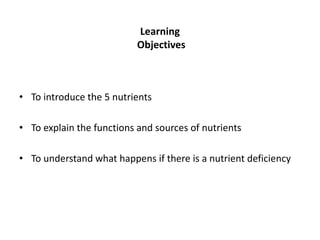
Nutrients - the basics
- 1. Learning Objectives • To introduce the 5 nutrients • To explain the functions and sources of nutrients • To understand what happens if there is a nutrient deficiency
- 2. Why do we eat food? Apart from enjoyment and social activity, we eat food because our bodies need: • energy; • compounds for growth, repair and reproduction; • substances to regulate the production of energy, growth and repair.
- 3. What are nutrients? Food contains a mixture of different nutrients which have different functions in the body. They are the chemicals found in food. There are 5 main nutrients: 1. Protein – HBV, LBV 2. Carbohydrates – Starch & Sugar 3. Fats 4. Vitamins – such as A,B group, C, D, E 5. Minerals – such as Iron & Calcium Water and fibre are also very important to include in the diet, but they are not classed as nutrients in this course. • Food is eaten and digested in the body to allow the absorption of energy and nutrients. • Each nutrient will have a different role / function in the diet • Each food contains different nutrients and in different amounts. • Different people need different quantities of each nutrient
- 4. The energy supply Foods containing… • protein • carbohydrate • fat …provide the body with energy. These are also known as ‘Macronutrients’
- 5. How is energy measured? Energy is measured in units known as kilojoules (kJ). Energy is also measured in calories (kcal). This is a different way of measuring energy, just as distance is measured in centimetres and inches. 1 calorie = 4.2 kJ
- 6. Energy and nutrients Food and drinks provide us with different amounts of energy because of the variety of nutrients they contain. 1g protein provides 17kJ (4 kcal). 1g carbohydrate provides 16kJ (3.75 kcal). 1g fat provides 37kJ (9 kcal).
- 7. The other functions Food also provides… • fibre; • water; • vitamins and minerals. These substances do not provide the body with energy, but are all needed to fulfil some important ‘support’ functions for the body.
- 8. Now let’s look a little closer at what else the nutrients do For this course, we only need to cover basic nutrition. You need to know and understand: Types of nutrients there are The functions of nutrients in the body The good sources of nutrients – i.e. what foods they are in Deficiency / Excess nutrients - the effects Nutritional requirements of different people What is a Healthy Balanced Diet
- 9. Protein What is the function of protein? Protein is needed by the body for growth, development and repair of body cells. It is Sometimes known as the ‘body builder’ Protein is really important as it is the only nutrient that can do this. Protein can also provide energy, but not as much as fat or carbohydrate. What consumers would need more protein? Why? Good sources of protein? There is protein in any natural product that has ‘grown’, but some foods are a better source than others: Animals – fish, meat, cheese, milk, eggs Plants – peas, beans, lentils,(sometimes called pulses) nuts and cereals HBV & LBV These are the 2 types of protein. HBV – High Biological Value LBV – Low Biological Value So what’s the difference?
- 10. Proteins are made up of amino acids. There are around 20 different types. There are 8 essential amino acids needed for adults and 10 for children. HBV proteins will have all essential LBV proteins will have some of the amino acids required essential amino acids required, therefore it is important to eat a variety of LBV protein sources Complimentary Proteins are a mixture of LBV proteins that together will provide all the essential amino acids. E.g. rice and peas
- 11. Fat What is the function of fat? Fat provides the body with essential fatty acids and energy. One gram of fat provides 37 kJ (9 calories), which is more than any other nutrient. Fat provides a store of energy for the body. Fat also provides protection for the major organs in the body. Fat carries important fat soluble vitamins (A, D, E and K) and is important for their absorption. Types of Fat . • saturated; • unsaturated; - monounsaturated; - polyunsaturated. Fat is needed for health, but only in moderate amounts. Too much fat can eventually lead to obesity, coronary heart disease and other health issues Saturated fat is the type that we should eat the least of. In cooking we use 2 main types – fats, which are solid at room temperature and oils which are liquid. What are sources of fat? Butter, margarine, lard, sunflower oil, sesame oil, cheese,
- 12. Where is fat found? Saturated fat can be found in meat, coconut oil, palm oil, cakes, biscuits, and lard. Unsaturated - Monounsaturated and polyunsaturated fat can be found in rapeseed oil, olive oil, oily fish, avocado and some margarines and low fat spreads.
- 13. Carbohydrate What is the function of Carbohydrates? They provides an important source of energy for the body. Carbohydrate provides 16kJ per gram. (half as much as Fat does) Types of Carbohydrates The two main types of carbohydrate are: 1) sugars; 2) starch. Whole grains are known as ‘complex’ carbohydrates Sugars are known as ‘simple’ carbohydrates, often being called ‘empty calories’ Good Sources of Carbohydrates Foods that fill you up are generally starchy carbohydrates e.g. bread, rice, pasta, Potato Foods that are sweet are sugar carbohydrate e.g sugar, honey , jam, fruit,
- 14. Where is carbohydrate found? Some examples of sugar sources (carbohydrate) are sucrose (found in table sugar), lactose (found in milk), and fructose (found in fruit). Some examples of food sources for starchy carbohydrates are bread, pasta, and cereal.
- 15. We will look at Micronutrients (Vitamins and Minerals), Water and Fibre in another lesson